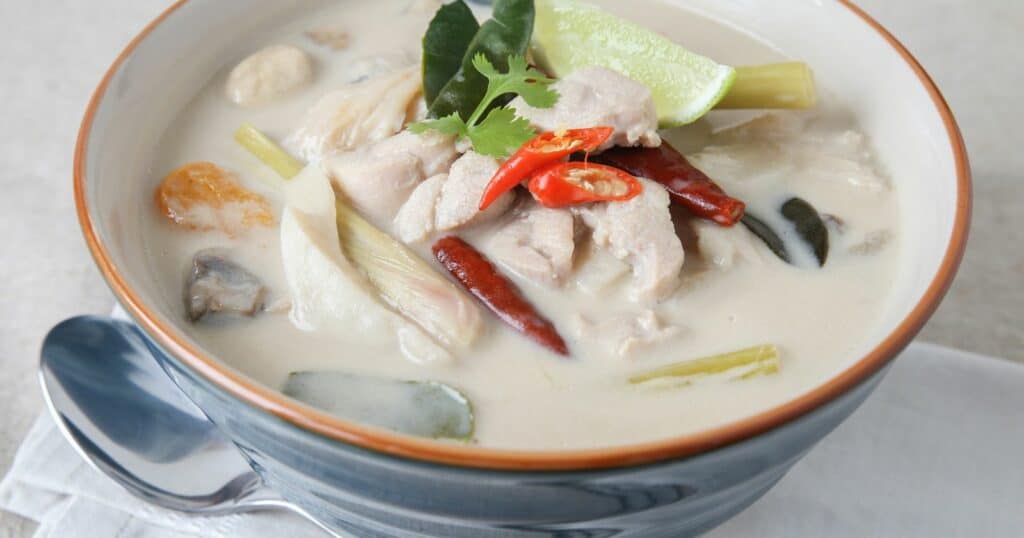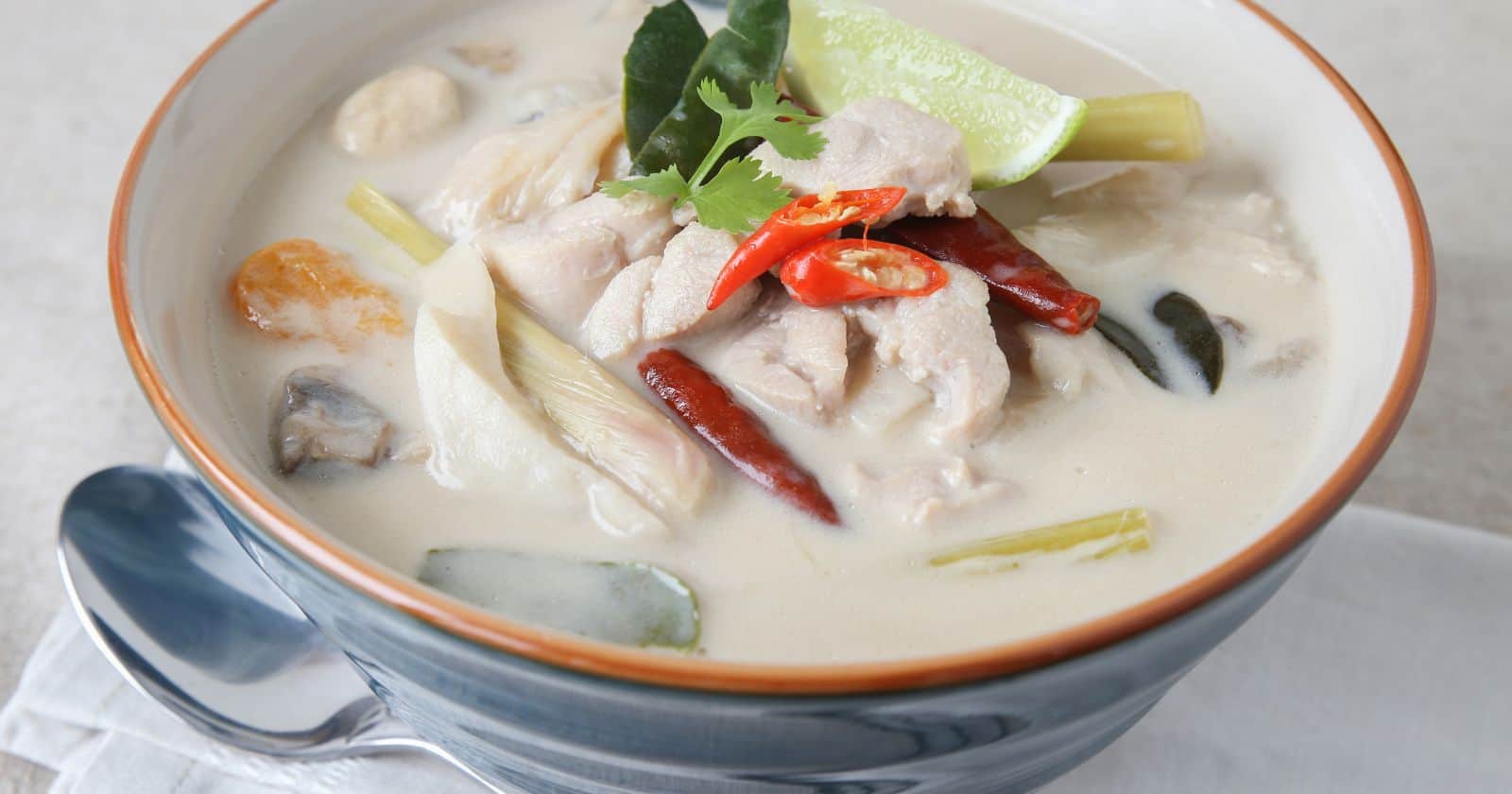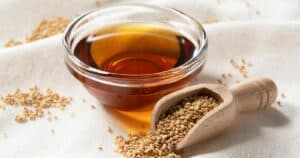Tom yum and tom kha – you may have heard these names before when savoring the flavors of Thai cuisine. But what exactly sets these two quintessential Thai soups apart?
At its core, the debate between tom yum versus tom kha comes down to a clash between
Tom yum spotlights sour, spicy, and salty flavors with its broth of lime, lemongrass, and chilies. This makes it a bang-up option for fierce foodies who crave excitement.
Tom kha, on the other hand, highlights the velvety richness of coconut milk mixed with aromatic Thai herbs. Its milder taste makes it an approachable gateway to Thai soups.
While personal taste will dictate which soup you’ll favor, understanding their distinctions is key. This article will explore all the ingredients, textures, aromas, and taste profiles that set tom yum and tom kha apart.
You’ll discover what gives each soup its trademark flavor. You’ll also learn creative ways to put new twists on these classics.
So let’s dive in and settle this spicy battle once and for all!
An Introduction to Thai Soup
Before diving into the distinctions between Tom Yum and Tom Kha, let’s briefly touch upon Thai soups as a whole.
Types of Thai Soup
There are numerous varieties of Thai soup, each with its own ingredients and preparation methods. Some major types include:
- Tom Yum – The hot and sour soup infused with lemongrass, galangal, and lime.
- Tom Kha – The milder coconut milk-based soup.
- Kaeng jeud – A Thai curry soup made with a variety of meats or vegetables.
- Gang liang – A nourishing herbal soup.
- Tom som – A sour soup made with a tamarind base.
Common Ingredients and Flavors
Certain ingredients and flavor elements commonly appear across many Thai soups:
- Lemongrass – Provides a strong, citrusy aroma.
- Galangal – A ginger-like rhizome that offers earthy, peppery notes.
- Kaffir lime leaves – Lend a bold, lime essence.
- Thai chilies – Bring spicy heat and a touch of sweetness.
- Fish sauce – Adds a savory, umami depth.
- Limes – Contribute tartness and acidity.
- Cilantro – Bright, fresh flavor and aroma.
This medley of herbs, spices, and components forms the backbone for many quintessential Thai soups.
Demystifying Tom Yum

Now let’s zero in on one of Thailand’s most iconic soups – Tom Yum. With its unmistakable infusion of aromatics and
The Origins of Tom Yum
While its exact roots are disputed, Tom Yum likely originated in central Thailand. The abundance of fresh shrimp from the Chao Phraya River provided ideal ingredients for this soup. The name “Tom Yum” comes from two Thai words – “tom” meaning “boil” and “yam” meaning “mixed.”
Ingredients in Tom Yum
Tom Yum has two primary components:
- Soup base – Made by boiling shrimp shells, lemongrass, galangal, kaffir lime leaves, shallots, and other aromatics. This creates an intensely flavored broth.
- Main ingredients – Most commonly shrimp, though variations can include chicken, fish, mushrooms, or vegetables.
Key seasonings include lime juice, fish sauce, cilantro, and Thai chilies. This adds sour, salty, herbal, and spicy notes.
Taste Profile of Tom Yum
The medley of ingredients gives Tom Yum a distinct hot, sour, and salty taste profile. Key flavors include:
- Sour – Lime juice provides pronounced tartness and acidity. This balances against the other flavors.
- Salty – Fish sauce lends a savory, umami-rich layer of flavor.
- Spicy – Thai chilies deliver intense heat, capsicum bite, and subtle sweetness.
- Herbal – Lemongrass, galangal, and kaffir lime leaves offer citrusy, earthy aromas.
The result is a bold, aromatic soup with layers of stimulate the palate.
Discovering Creamy Tom Kha

Another famed Thai soup, Tom Kha, offers a very different experience compared to Tom Yum. With its coconut milk base and mellower
History of Tom Kha
Tom Kha dates back to around 1890 and first appeared in Thai recipe books around that time. It showcases ingredients commonly found in Thai cuisine, like galangal, lemongrass, and kaffir lime leaves.
Typical Tom Kha Ingredients
Coconut milk forms the foundation of Tom Kha, creating its trademark creamy texture. Chicken and shrimp are common proteins. The soup also contains:
- Galangal – For its peppery, gingery essence.
- Lemongrass – To provide citrusy floral notes.
- Kaffir lime leaves – For an intense lime aroma.
- Mushrooms – Add an earthy, meaty quality.
- Tomatoes – Contribute a sweet, tart juiciness.
Flavor Profile of Tom Kha
Compared to Tom Yum, Tom Kha has a milder, more balanced flavor combining:
- Sweet – Coconut milk provides natural sweetness.
- Sour – Lime juice and tomatoes offer a gentle tartness.
- Salty – A touch of fish sauce brings out the other flavors.
- Spicy – Chilies add subtle heat and fruitiness.
The overall effect is a rich, creamy, and aromatic soup showcasing Thai herbs and spices.
Tom Yum vs. Tom Kha: Key Differences
Now that we’ve explored both soups, let’s directly compare Tom Yum and Tom Kha side-by-side:
| Tom Yum | Tom Kha | |
|---|---|---|
| Base | Clear broth | Coconut milk |
| Spiciness | Very spicy | Mildly spicy |
| Flavor profile | Hot, sour, salty | Creamy, mild, sweet |
| Aroma | Strong citrus, herbs | Coconut, ginger, lime |
| Ingredients | Shrimp, lemongrass, galangal, kaffir lime leaves, chilies | Chicken, mushrooms, tomatoes, galangal |
| Texture | Light broth | Silky, creamy |
As shown above, the two soups differ significantly in terms of base,
Health Benefits: Herbs and Spices
Beyond their outstanding flavors, Tom Yum and Tom Kha provide valuable health benefits, thanks to their fresh herbs and spices:
- Lemongrass has antioxidant and anti-inflammatory effects.
- Galangal aids digestion and relieves nausea.
- Turmeric contains anti-inflammatory curcumin.
- Chilies offer pain relief and metabolic benefits.
- Lime provides immune-boosting vitamin C.
So sipping these soups nourishes your body along with satisfying your taste buds!
Soothing Colds and Flu
When feeling under the weather, tom yum and tom kha provide the perfect remedy:
- The chili heat helps clear sinus congestion and opens airways.
- Lemongrass, lime, and ginger contain anti-inflammatory compounds to combat aches.
- The hydrating broth and electrolytes aid recovery and rehydration.
- Chicken versions provide nourishment when appetite is low.
Let the restorative properties of Thai herbs nurse you back to health! The spicy heat helps relieve stuffy noses, while the broth soothes scratchy throats. The vegetables and herbs also boost the immune system to fight off the infection.
Ranking All Thai Soup From Spiciest to Least
Thai cuisine is renowned for its fiery flavors. For those who love
- Tom Yum – With its double hit of chilies and peppercorns, tom yum tops the list as the spiciest and most incendiary Thai soup. Its heat is legendary.
- Jungle Curry Soup – Filled with intensely hot green peppercorns and aromatics like kaffir lime leaves, this curry soup packs a jungle-like punch.
- Tom Som – The sour tamarind base of tom som provides a lip-puckering
spice . Dried chilies add even more searing flavor. - Tom Kha – While milder than tom yum, tom kha can still bring on some slow-simmering
spice from chilies and pepper. - Kaeng Liang – A curry-based herbal soup made fiery by the inclusion of fresh green chilies.
- Gang Garee – Yellow curry paste and Indian spices give this soup a formidable kick.
- Gang Jeud – Lean, clear, and super spicy, this soup gets heat from a blend of chili and garlic.
For thrill seekers and chiliheads, these Thai soups offer the perfect way to break a sweat and set your mouth ablaze. Just have plenty of beer or milk on hand to cool down!
The Verdict: Yum or Kha?
So when it comes down to the fiery debate of Tom Yum vs Tom Kha, which soup reigns supreme?
While personal taste preferences will vary, here are some key points to consider:
For Tom Yum:
- Its bold, stimulating flavors are ideal for
spice lovers. - The light broth is refreshing in hot climates.
- It pairs well with a variety of proteins like seafood.
For Tom Kha:
- The creamy richness provides comforting satisfaction.
- It’s more approachable for those who avoid intense heat.
- The coconut milk makes it dairy-free and vegan.
At the end of the day, the best Thai soup for you depends on your own palate. The good news is that you can’t go wrong with either of these stellar options!
So grab your spoon, pull up a chair, and sip and savor the symphony of flavors in Tom Yum and Tom Kha. These soups showcase the diversity of tastes that make Thai cuisine so crave-worthy. Whether it’s the hot kick of Tom Yum or the velvety caress of Tom Kha, let these soups transport your tastebuds on an unforgettable journey. Kampung!





